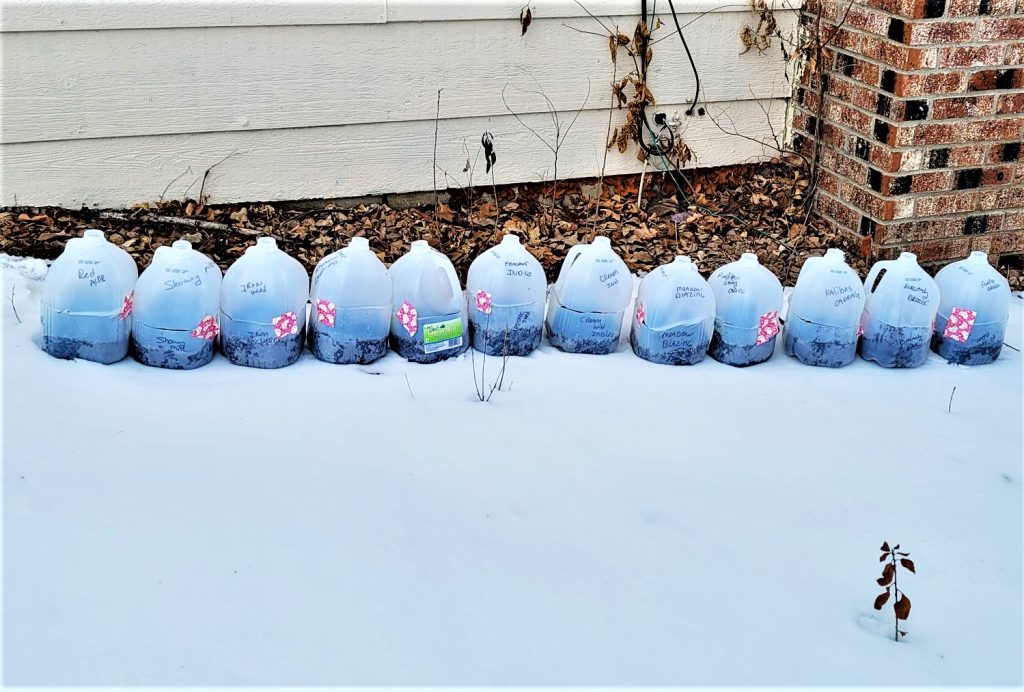Milk Jug Gardening (Wintersowing) Revisited … If at first you don’t succeed, try, try again

 There was one column topic that I had more feedback about than all the others last year –Milk Jug Gardening: Wintersowing. And it wasn’t all good news; many people had limited success or wondered why their plants were so small.
There was one column topic that I had more feedback about than all the others last year –Milk Jug Gardening: Wintersowing. And it wasn’t all good news; many people had limited success or wondered why their plants were so small.
So I am circling back to address these issues and hope you give it a try again this year. Why not? What else do gardeners have to do in February?
So a quick review: Wintersowing was a type of seed begun by a single person, Trudi Davidoff, that started a seed starting revolution. She didn’t have much room or resources for seed starting indoors, but she looked at a plastic gallon jug, and bam! The idea of using them as a mini greenhouse was born.
But could you really put seeds that normally are started in the tender, warm, temperature-controlled confines of a greenhouse, outside in winter? Surely, they would rot and die and never germinate. But surprisingly, they thrived. But not in the way we normally think of transplants.
That is where people who tried this last year, felt they failed. They did not. It is the way wintersown transplants grow that is different, and therefore, you have to learn how to treat them differently.
The three keys why some people who tried wintersowing had limited success were: They kept the lid on the jug; they expected wintersown transplants to be large like indoor/greenhouse grown transplants; and Mother Nature gave us the darkest, coolest April last year. Two of those things we can fix the other was an exception out of our control.
So, this year as you start making your wintersown jugs, be sure you discard (hopefully recycle) the cap. The point is that rain, snow, sleet become the automatic watering system that makes wintersowing so effortless. And remember what goes in, needs to come out when it comes to moisture, so be sure to cut large drainage holes in the bottom.
About the difference in transplant size and timing — When you go to your local greenhouse or big box store to get your transplants in April or May, they are huge compared to wintersown transplants.
That is where the confusion starts. Store transplants (or those you start inside yourself) are grown in conditions that mimic warmer conditions that wouldn’t arrive here until May or June. When we teach kids about why farmers who grow tomatoes have to start tomato plants inside in March, we tell them it is to “fool” the tomato seeds into thinking they are in Peru (the country), tomatoes are native and where it is warm all the time.
With wintersowing, you need to throw that image of 4” tall or larger transplants out the window. That is not what you will get when wintersowing. Nor will it coordinate with the same time of planting.
Let me explain: Wintersowing lets Mother Nature take the driver’s seat; not the gardener. You sow your jugs in February or March. Nature at that time is usually quite cold and wet. The seeds remain in a suspended animation state until, the light/dark cycle turns the lights on and with increasing number of daylight hours. So you are not going to see germination anytime soon.
But wait, there is more …
Below the surface is where the real magic of wintersowing takes place. As the potting mix (not potting soil or, heaven forbid, garden soil) freezes and thaws, it helps the seed coats to crack and start to take in moisture. Seeds drinking in moisture is called imbibition. I think of seeds as the perfect gift. They contain all the genetic material necessary to create the plant and a little sack lunch of food to get the seed going. The water and freeze/thaw cycle are the tools that open the present.
Remember, that above ground it is still cold and not very sunny, so the wintersown plants focus on developing extraordinary deep, robust root systems first. The roots are the foundation of plants — the quality of the top are based on how strong the foundation is — for the lifetime of the plant.
That is why wintersown transplants are moved when the top is quite immature still; that robust root system will get them going and growing.
Now a quick little botany lesson: Plants are divided into two categories — single leaf (monocot) and two leaf (dicot). Think of when seeds emerge from the ground. When grass seed grows, it sends up one leaf, just like hostas, dayliles and grasses do.
Dicots are broadleaf plants, think of that typical photo of a seedling. You see two large, flat leaves that come up at the same time. Dicots are most of our plants that we start from seed: tomatoes, peppers, flowers, weeds … oh wait, we don’t intentionally start those.
So, it is hard to believe that after those first seed leaves, you only need one or two sets of new leaves to form, and then you are ready to transplant your wintersown seedlings.
Bigger is not better here. The first time I did it, I could not believe that any of them would live, but they not only survived but were bigger and better than any other transplants I bought. Why? Because of that slow and low foundational root system.
Remember, the value of buying seeds over plants is extremely economical. Even with higher prices on everything these days. I am forever amazed that a single seed weighing less than an eyelash can produce a bushel full of vegetables or flowers.
So, give wintersowing another try; you will be glad you did.